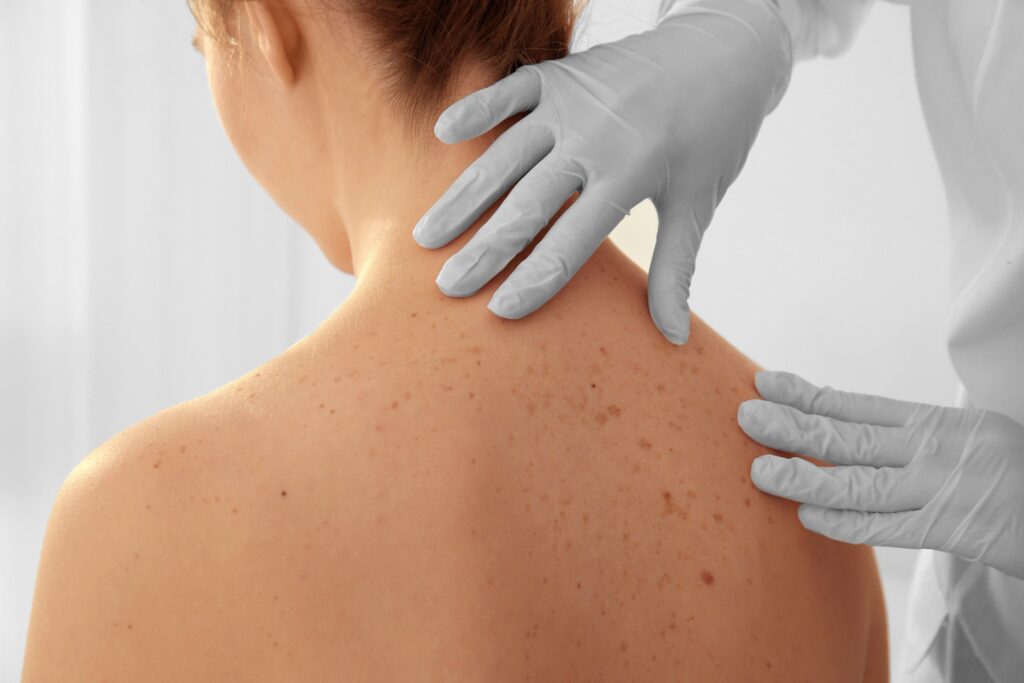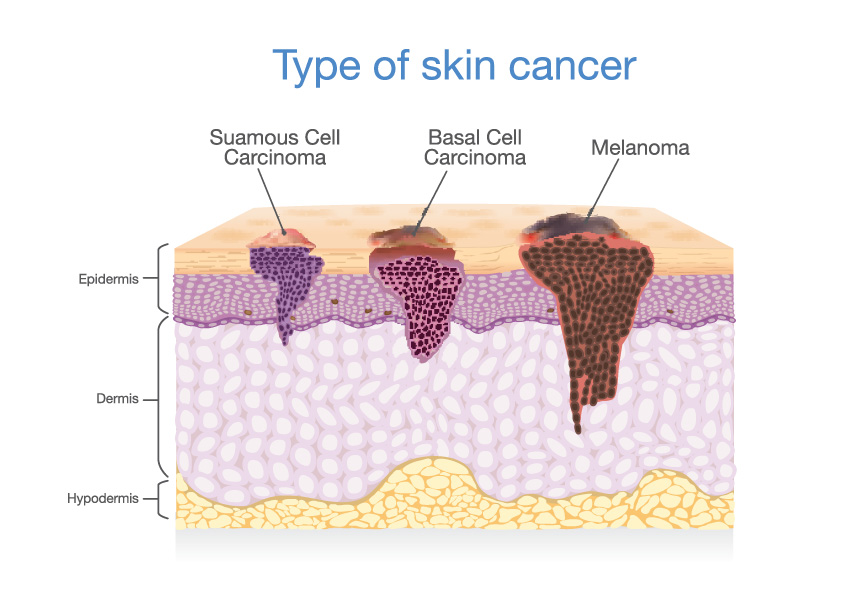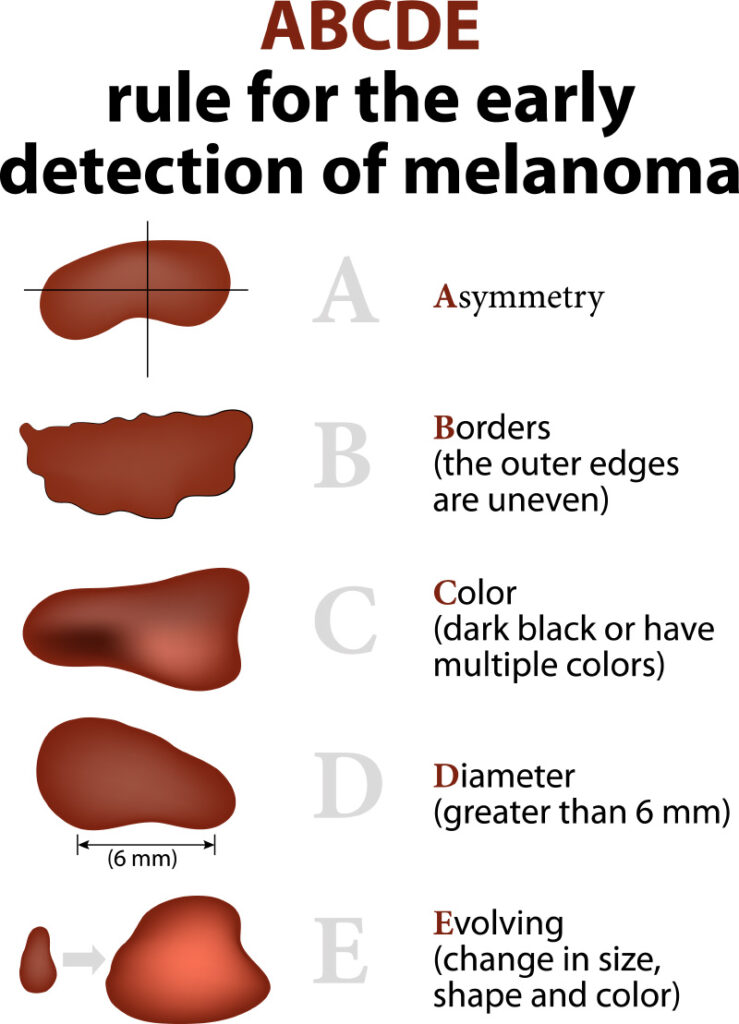Skin Cancer
Most people don’t start seeing a dermatologist until there is already a problem, especially when it comes to signs of skin cancer. But, it’s essential to remember that skin cancers are generally curable when caught early.
Learn more about skin cancer, and what you should do if you have spotted signs of skin cancer below.

What is skin cancer?
Skin cancer is the most common form of cancer. It affects more than one million Americans each year, while one in five Americans will develop skin cancer at some point in their life. Skin cancer is caused by the out of control growth of abnormal skin cells. It occurs when the DNA in your skin cells is damaged, usually by ultraviolet radiation from the sun or tanning beds.
What are the different types of skin cancer?
Skin cancer is categorized into two categories: non-melanoma skin cancer and melanoma skin cancer.
Non-melanoma skin cancers can include:
- Basal cell carcinoma (BCC) — This type of skin cancer is found in the deepest layer of your epidermis (outer layer of skin). Basal cell carcinoma is the most common form of skin cancer, but it rarely spreads throughout the body. If caught early, the prognosis is good, but it must be treated quickly.
- Squamous cell carcinoma (SCC) — SCC is the second most common form of skin cancer and affects the squamous cells in the skin’s top layers. Like other pre-cancers and cancers, they’re most common in areas of the body repeatedly exposed to the sun. It is essential that SCC is caught early, as cancer can be disfiguring or even deadly. SCC can develop from actinic keratosis.
- Merkel Cell Carcinoma — MCC is a very rare type of skin cancer.
- Cutaneous T-Cell Lymphoma — Like MCC, Cutaneous T-Call Lymphoma is a very rare type of skin cancer.
- Sebaceous Carcinoma — Sebaceous Carcinoma is a very rare type of skin cancer.
Melanoma skin cancer: Melanoma causes the most deaths of any skin cancer, killing more than 10,000 people in the US every year. Melanoma can develop from existing moles or may look like a mole. While moles are not cancerous, they can be early signs of melanoma. They’re usually brown or black, but sometimes they are pink, red, blue, white or even the same color as the surrounding skin. The risk of melanoma is drastically increased with every sunburn you get. If you have had more than five sunburns, your risk of melanoma has doubled. If it is caught early, patients have an excellent outlook; however, it can spread to other parts of the body. It’s crucial to find it before it spreads, which means frequent skin checks are necessary.

Who is at risk for skin cancer?
Anyone can get skin cancer, but there are individuals who have an increased risk, including:
- Individuals with fair skin.
- History of chronic sun exposure.
- History of severe sunburns.
- History of tanning bed use.
- History of radiation therapy. Radiation therapy to treat acne or other skin conditions may increase the risk of skin cancer at previous treatment sites on the skin.
- Personal or family history of skin cancer.
- Individuals on immune-suppressing drugs. For example, transplant patients on chronic suppressive drugs.
- Exposure to high levels of arsenic. Arsenic is a toxic metal that’s found widely in the environment.
- Inherited syndromes that cause skin cancer. Certain genetic diseases can increase the risk of skin cancer, such as Albinism.
What are some characteristics of the most common types of skin cancer?
As a general rule, any new or existing changing lesion should be checked by your dermatologist as soon as possible. Skin cancer can take many shapes and forms. Here is a general guideline for the most common types of skin cancer.
BASAL CELL CARCINOMA (BCC)
Basal Cell Carcinoma (BCC) growths can look like open sores, smooth, shiny bumps, scars, or pink/red areas of skin.
SQUAMOUS CELL CARCINOMA(SCC)
Squamous Cell Carcinoma (SCC), growths are usually raised from the surrounding skin and can look crusty. They may bleed and can sometimes appear as open sores.
MELANOMA
The first sign of a melanoma is an unusual looking freckle or mole. However, there is an acronym called ABCDE of melanoma, developed by the American Academy of Dermatology, that can help you and your dermatologist identify melanoma.
- Asymmetry: Half of the mole does not match the other half in size, shape or color.
- Border: The edges of moles are irregular, scalloped, or poorly defined.
- Color: The mole is not the same color throughout.
- Diameter: The mole is usually higher than 6 millimeters when diagnosed but may also be smaller.
- Evolving: A mole or skin lesion that is different from the rest or changes in size, shape or color.

What are the treatments of the most common types of skin cancer?
Non-melanoma skin cancers (BCC & SCC) share some common treatments. Treatment varies based on size, type, and depth of skin cancer.
- Topical creams applied at home: These are prescription creams that target and destroy cancer cells.
- Electrodesiccation and Curettage (ED&C): A surgical technique involving a curette to scrape the cancer cells and electrodesiccation to destroy any remaining cancer cells with heat.
- Photodynamic therapy: Photodynamic therapy is the combination of a photosensitizing drug and light to treat skin cancers.
- Simple excision: A surgical procedure where your dermatologist cuts out the skin cancer and surrounding normal skin around it to remove any skin cancer cells that are astray.
- Mohs surgery: Mohs surgery involves the removal of the cancer layer by layer and examining each layer under the microscope until no abnormal cells remain.
- Radiation therapy: Radiation therapy is usually an option for people who can’t undergo surgery or for patients after surgery who are at an increased risk for skin cancer to return.
- Oral Medications for BCC: When BCC has become inoperable or has returned after surgery, there are oral medications that can be prescribed.
- Immunotherapy for SCC: This type of prescription can help the patient’s immune system fight and destroy the cancer cells.
- Chemotherapy for SCC: When treating advanced SCC, there are different types of chemotherapy drugs used and are typically given by intravenous drip.

Treatment for Melanoma is complex due to varying factors such as:
- The type of melanoma you have
- The depth of melanoma that has grown into the skin
- The growth and division rate of melanoma cells
- Whether it has spread to another part of your body
When discussing your treatment plan, your dermatologist will take the above into account when determining the best option, which could include:
- Simple excision:A surgical procedure where your dermatologist cuts out the skin cancer and surrounding normal skin around it to remove any skin cancer cells that are astray.
- Lymphadenectomy: For deeper melanoma sites, this procedure will remove the lymph nodes.
- Immunotherapy: This type of prescription can help the patient’s immune system fight and destroy the cancer cells.
- Targeted therapy: This therapy targets the cancer cells to shrink them.
- Chemotherapy: While chemotherapy is often less used due to new medications emerging, this type of treatment can destroy fast-growing cells.
- Radiation therapy: Radiation therapy is usually an option for people who can’t undergo surgery or for patients after surgery who are at an increased risk for skin cancer to return.
- Immunotherapy, targeted therapy, chemotherapy, and radiation therapy are all used for deep melanoma treatment.
How can my dermatologist help?
Dermatologists have a trained eye for early detection of skin cancer. Start seeing a dermatologist every year to have your skin checked for pre-cancers and skin cancers. Your dermatologist wants to help you develop an excellent preventive skincare routine that reduces your risk of pre-cancers and skin cancers.
Our staff is dedicated to keeping up-to-date with the most advanced procedures and patient education. If you think you may be at risk for skin cancer and you would like a consultation, please contact us.
Dermatology Center for Skin Health, PLLC
600 Suncrest Towne Centre, Suite 115
Morgantown, WV 26505
Our office is located on the ground floor of the 600 Suncrest Towne Centre Building. Please enter through the middle doors at the front of the building. The Dermatology Center for Skin Health, PLLC, entrance is located just inside the building — first door on the right.
You can also text us to make an appointment.
To communicate with us from a mobile phone, click the button below or send a text to the number.

